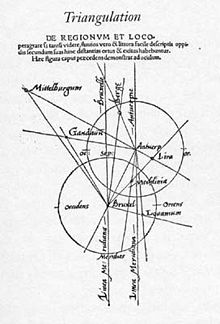Triangulation (surveying)

In surveying, triangulation is the process of determining the location of a point by measuring only angles to it from known points at either end of a fixed baseline by using trigonometry, rather than measuring distances to the point directly as in trilateration. The point can then be fixed as the third point of a triangle with one known side and two known angles.
Triangulation can also refer to the accurate
Principle

Triangulation may be used to find the position of the ship when the positions of A and B are known. An observer at A measures the angle α, while the observer at B measures β.
The position of any vertex of a triangle can be calculated if the position of one side, and two angles, are known. The following
Calculation
With being the distance between A and B gives:
Using the
therefore:
From this, it is easy to determine the distance of the unknown point from either observation point, its north/south and east/west offsets from the observation point, and finally its full coordinates.
History



Triangulation today is used for many purposes, including
In the field, triangulation methods were apparently not used by the Roman specialist land surveyors, the
Gemma Frisius
On land, the cartographer
Willebrord Snell
The modern systematic use of triangulation networks stems from the work of the Dutch mathematician Willebrord Snell, who in 1615 surveyed the distance from Alkmaar to Breda, approximately 72 miles (116 kilometres), using a chain of quadrangles containing 33 triangles in all. Snell underestimated the distance by 3.5%. The two towns were separated by one degree on the meridian, so from his measurement he was able to calculate a value for the circumference of the earth – a feat celebrated in the title of his book Eratosthenes Batavus (The Dutch Eratosthenes), published in 1617. Snell calculated how the planar formulae could be corrected to allow for the curvature of the earth. He also showed how to resection, or calculate, the position of a point inside a triangle using the angles cast between the vertices at the unknown point. These could be measured much more accurately than bearings of the vertices, which depended on a compass. This established the key idea of surveying a large-scale primary network of control points first, and then locating secondary subsidiary points later, within that primary network.
Further developments
Snell's methods were taken up by
Triangulation methods were by now well established for local mapmaking, but it was only towards the end of the 18th century that other countries began to establish detailed triangulation network surveys to map whole countries. The
Today, large-scale triangulation networks for positioning have largely been superseded by the
See also
- Anglo-French Survey (1784–1790)
- Bilby tower
- Great Trigonometrical Survey
- Multilateration, where a point is calculated using the time-difference-of-arrival between other known points
- Parallax
- Resection (orientation)
- SOCET SET
- Spherical trigonometry
- Stellar triangulation
- Stereopsis
- Trig point
References
- ^ ISBN 0-87548-422-0. pp. 119–122
- ^ O'Connor, John J.; Robertson, Edmund F., "Abu Arrayhan Muhammad ibn Ahmad al-Biruni", MacTutor History of Mathematics Archive, University of St Andrews
- ^ Michael Jones (2004), "Tycho Brahe, Cartography and Landscape in 16th Century Scandinavia", in Hannes Palang (ed), European Rural Landscapes: Persistence and Change in a Globalising Environment, p.210
- ^ Martin and Jean Norgate (2003), Saxton's Hampshire: Surveying, University of Portsmouth
Further reading
- Bagrow, L. (1964) History of Cartography; revised and enlarged by R.A. Skelton. Harvard University Press.
- Crone, G.R. (1978 [1953]) Maps and their Makers: An Introduction to the History of Cartography (5th ed).
- Tooley, R.V. & Bricker, C. (1969) A History of Cartography: 2500 Years of Maps and Mapmakers
- Keay, J. (2000) The Great Arc: The Dramatic Tale of How India Was Mapped and Everest Was Named. London: Harper Collins. ISBN 0-00-257062-9.
- Murdin, P. (2009) Full Meridian of Glory: Perilous Adventures in the Competition to Measure the Earth. Springer. ISBN 978-0-387-75533-5.





